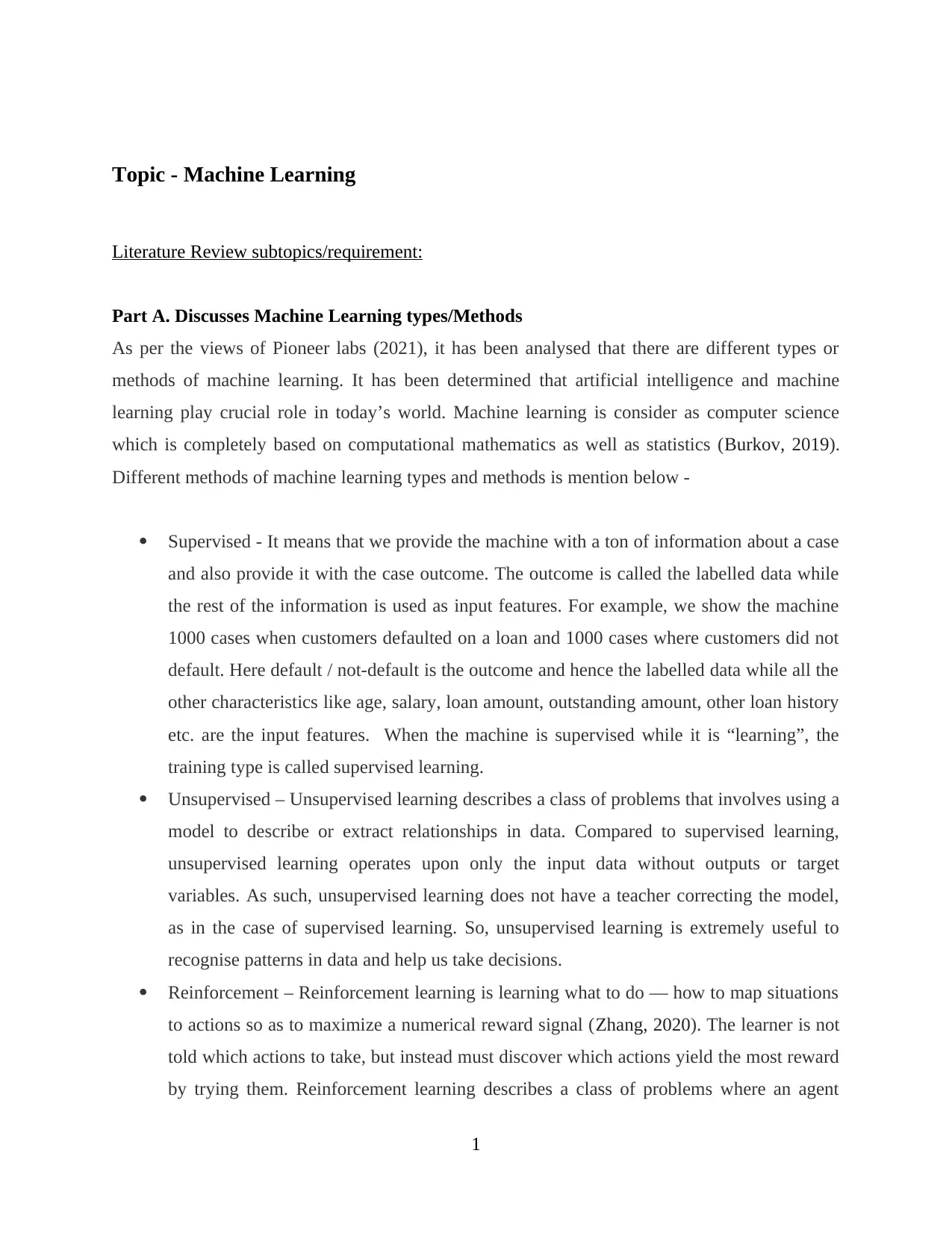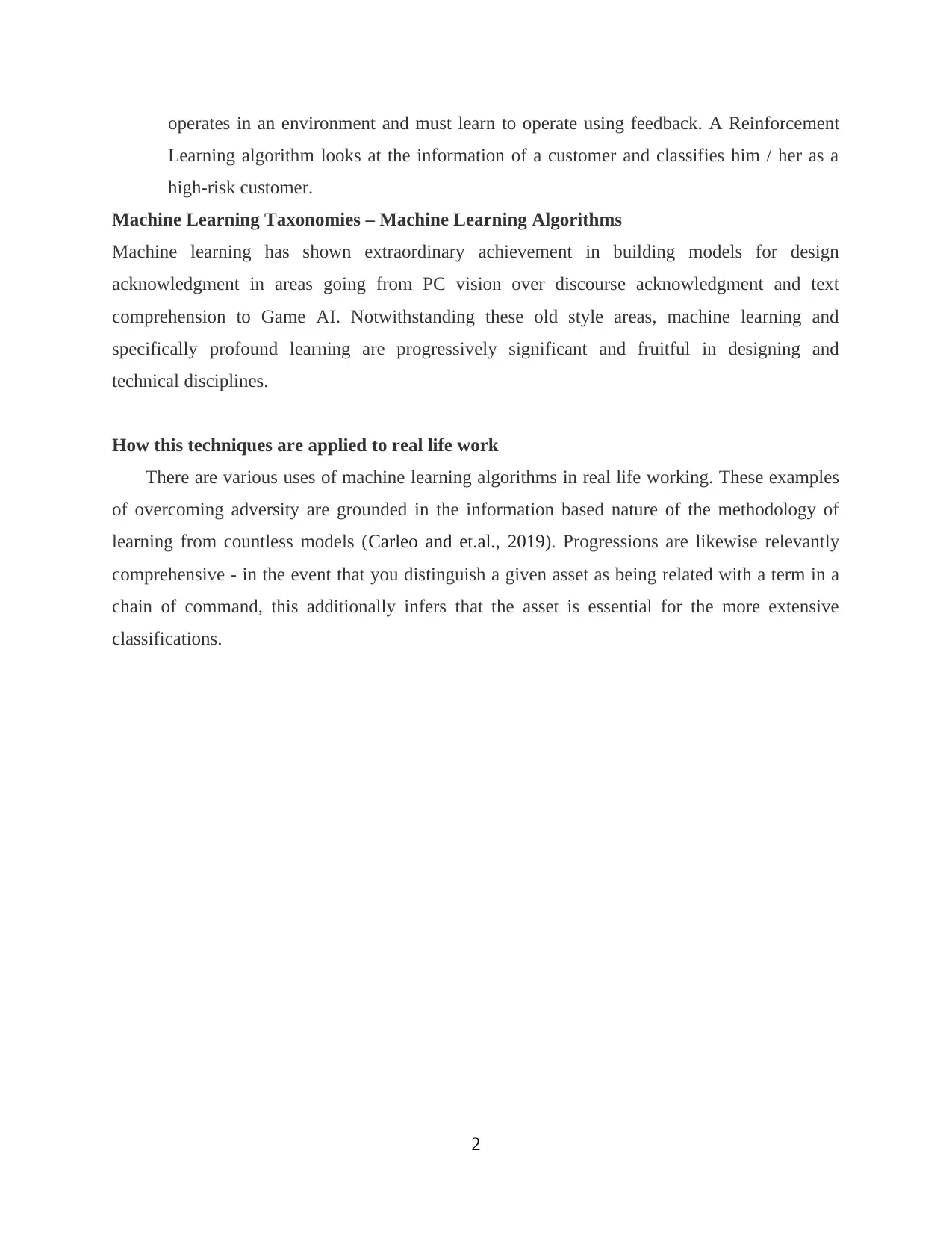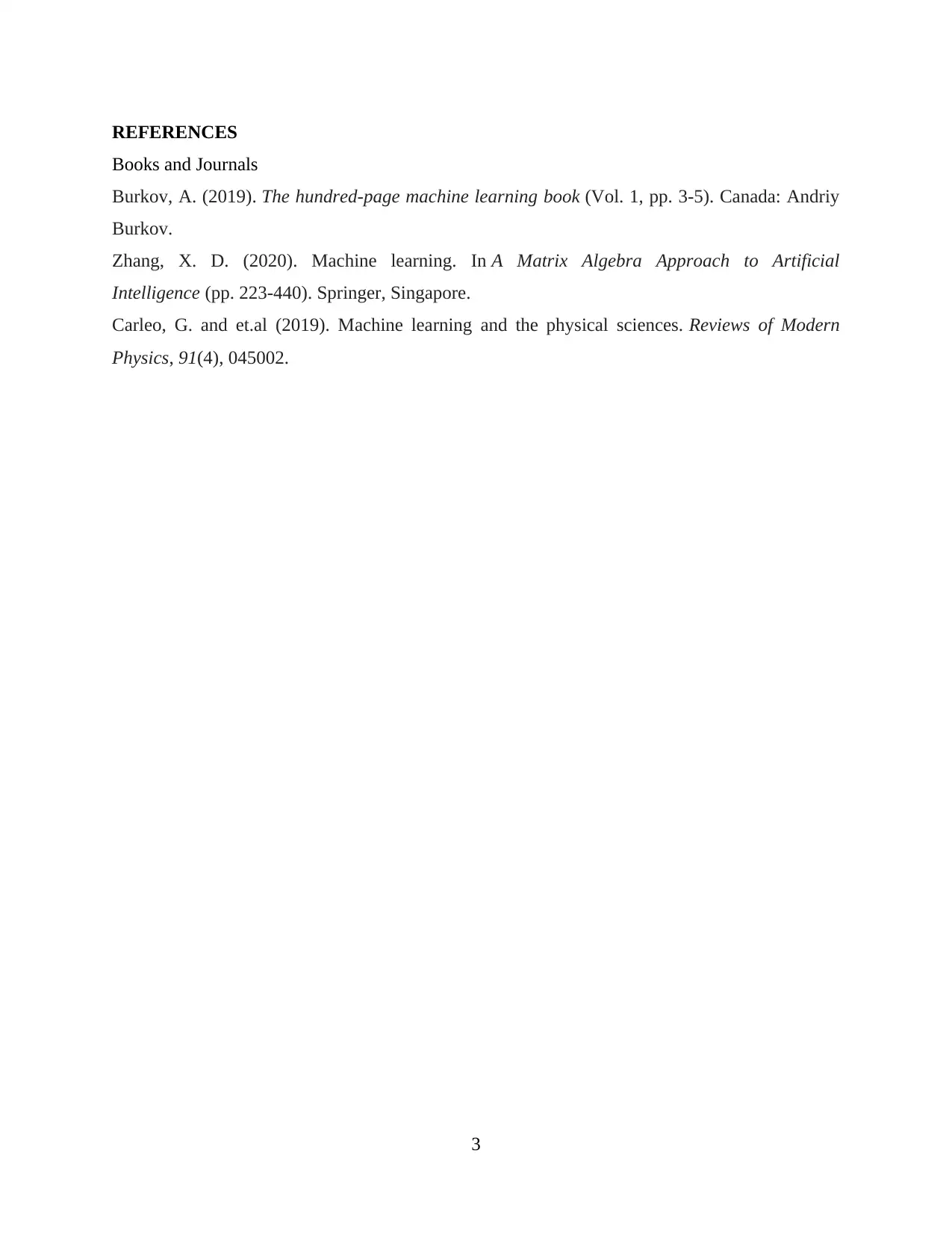Literature Review: Machine Learning Algorithms and Methods
VerifiedAdded on 2022/11/25
|5
|667
|327
Literature Review
AI Summary
This document provides a concise literature review of machine learning, exploring various aspects of the field. It begins by defining machine learning and its significance, then delves into different types, including supervised, unsupervised, and reinforcement learning. The review highlights the core concepts and differences between these methods. The document also discusses how these machine learning techniques are applied in real-life scenarios, providing a brief overview of their practical uses. Finally, it references key sources like books and journals that support the information presented in the review. The document is a brief but informative overview suitable for students learning about machine learning fundamentals.

Machine learning and literature review
Paraphrase This Document
Need a fresh take? Get an instant paraphrase of this document with our AI Paraphraser

Table of Contents
Topic - Machine Learning...............................................................................................................1
Literature Review subtopics/requirement:...................................................................................1
REFERENCES................................................................................................................................3
Topic - Machine Learning...............................................................................................................1
Literature Review subtopics/requirement:...................................................................................1
REFERENCES................................................................................................................................3

Topic - Machine Learning
Literature Review subtopics/requirement:
Part A. Discusses Machine Learning types/Methods
As per the views of Pioneer labs (2021), it has been analysed that there are different types or
methods of machine learning. It has been determined that artificial intelligence and machine
learning play crucial role in today’s world. Machine learning is consider as computer science
which is completely based on computational mathematics as well as statistics (Burkov, 2019).
Different methods of machine learning types and methods is mention below -
Supervised - It means that we provide the machine with a ton of information about a case
and also provide it with the case outcome. The outcome is called the labelled data while
the rest of the information is used as input features. For example, we show the machine
1000 cases when customers defaulted on a loan and 1000 cases where customers did not
default. Here default / not-default is the outcome and hence the labelled data while all the
other characteristics like age, salary, loan amount, outstanding amount, other loan history
etc. are the input features. When the machine is supervised while it is “learning”, the
training type is called supervised learning.
Unsupervised – Unsupervised learning describes a class of problems that involves using a
model to describe or extract relationships in data. Compared to supervised learning,
unsupervised learning operates upon only the input data without outputs or target
variables. As such, unsupervised learning does not have a teacher correcting the model,
as in the case of supervised learning. So, unsupervised learning is extremely useful to
recognise patterns in data and help us take decisions.
Reinforcement – Reinforcement learning is learning what to do — how to map situations
to actions so as to maximize a numerical reward signal (Zhang, 2020). The learner is not
told which actions to take, but instead must discover which actions yield the most reward
by trying them. Reinforcement learning describes a class of problems where an agent
1
Literature Review subtopics/requirement:
Part A. Discusses Machine Learning types/Methods
As per the views of Pioneer labs (2021), it has been analysed that there are different types or
methods of machine learning. It has been determined that artificial intelligence and machine
learning play crucial role in today’s world. Machine learning is consider as computer science
which is completely based on computational mathematics as well as statistics (Burkov, 2019).
Different methods of machine learning types and methods is mention below -
Supervised - It means that we provide the machine with a ton of information about a case
and also provide it with the case outcome. The outcome is called the labelled data while
the rest of the information is used as input features. For example, we show the machine
1000 cases when customers defaulted on a loan and 1000 cases where customers did not
default. Here default / not-default is the outcome and hence the labelled data while all the
other characteristics like age, salary, loan amount, outstanding amount, other loan history
etc. are the input features. When the machine is supervised while it is “learning”, the
training type is called supervised learning.
Unsupervised – Unsupervised learning describes a class of problems that involves using a
model to describe or extract relationships in data. Compared to supervised learning,
unsupervised learning operates upon only the input data without outputs or target
variables. As such, unsupervised learning does not have a teacher correcting the model,
as in the case of supervised learning. So, unsupervised learning is extremely useful to
recognise patterns in data and help us take decisions.
Reinforcement – Reinforcement learning is learning what to do — how to map situations
to actions so as to maximize a numerical reward signal (Zhang, 2020). The learner is not
told which actions to take, but instead must discover which actions yield the most reward
by trying them. Reinforcement learning describes a class of problems where an agent
1
⊘ This is a preview!⊘
Do you want full access?
Subscribe today to unlock all pages.

Trusted by 1+ million students worldwide

operates in an environment and must learn to operate using feedback. A Reinforcement
Learning algorithm looks at the information of a customer and classifies him / her as a
high-risk customer.
Machine Learning Taxonomies – Machine Learning Algorithms
Machine learning has shown extraordinary achievement in building models for design
acknowledgment in areas going from PC vision over discourse acknowledgment and text
comprehension to Game AI. Notwithstanding these old style areas, machine learning and
specifically profound learning are progressively significant and fruitful in designing and
technical disciplines.
How this techniques are applied to real life work
There are various uses of machine learning algorithms in real life working. These examples
of overcoming adversity are grounded in the information based nature of the methodology of
learning from countless models (Carleo and et.al., 2019). Progressions are likewise relevantly
comprehensive - in the event that you distinguish a given asset as being related with a term in a
chain of command, this additionally infers that the asset is essential for the more extensive
classifications.
2
Learning algorithm looks at the information of a customer and classifies him / her as a
high-risk customer.
Machine Learning Taxonomies – Machine Learning Algorithms
Machine learning has shown extraordinary achievement in building models for design
acknowledgment in areas going from PC vision over discourse acknowledgment and text
comprehension to Game AI. Notwithstanding these old style areas, machine learning and
specifically profound learning are progressively significant and fruitful in designing and
technical disciplines.
How this techniques are applied to real life work
There are various uses of machine learning algorithms in real life working. These examples
of overcoming adversity are grounded in the information based nature of the methodology of
learning from countless models (Carleo and et.al., 2019). Progressions are likewise relevantly
comprehensive - in the event that you distinguish a given asset as being related with a term in a
chain of command, this additionally infers that the asset is essential for the more extensive
classifications.
2
Paraphrase This Document
Need a fresh take? Get an instant paraphrase of this document with our AI Paraphraser

REFERENCES
Books and Journals
Burkov, A. (2019). The hundred-page machine learning book (Vol. 1, pp. 3-5). Canada: Andriy
Burkov.
Zhang, X. D. (2020). Machine learning. In A Matrix Algebra Approach to Artificial
Intelligence (pp. 223-440). Springer, Singapore.
Carleo, G. and et.al (2019). Machine learning and the physical sciences. Reviews of Modern
Physics, 91(4), 045002.
3
Books and Journals
Burkov, A. (2019). The hundred-page machine learning book (Vol. 1, pp. 3-5). Canada: Andriy
Burkov.
Zhang, X. D. (2020). Machine learning. In A Matrix Algebra Approach to Artificial
Intelligence (pp. 223-440). Springer, Singapore.
Carleo, G. and et.al (2019). Machine learning and the physical sciences. Reviews of Modern
Physics, 91(4), 045002.
3
1 out of 5
Related Documents
Your All-in-One AI-Powered Toolkit for Academic Success.
+13062052269
info@desklib.com
Available 24*7 on WhatsApp / Email
![[object Object]](/_next/static/media/star-bottom.7253800d.svg)
Unlock your academic potential
Copyright © 2020–2025 A2Z Services. All Rights Reserved. Developed and managed by ZUCOL.





